Reigning FIFA World Cup champions Argentina demolished Copa América Group A, winning all three of their group stage games, impressively scoring five goals and conceding zero.
The latter statistic is the one we’re going to be focusing more on in this tactical analysis piece and team-focused scout report analysing Lionel Scaloni’s Argentina, along with two other sides who have, thus far, performed very well in the USA-hosted tournament and all but secured their place in the knockout stages after playing just two games at the time of writing — Marcelo Bielsa’s Uruguay and Néstor Lorenzo’s Colombia.
Just as Argentina did, Uruguay and Colombia have both won each of their first two group stage games, with an intriguing, high-stakes clash with the United States and a mouthwatering showdown for Group D supremacy all that remains for Uruguay and Colombia, respectively, before the Copa América quarter-finals commence.
Argentina are the only side to go through the group stage without conceding a single goal, but despite not keeping a perfect defensive record like La Albiceleste, both Colombia and Uruguay have also stood out with their solid out-of-possession performances so far, with both sides conceding just once in their opening two games.
The underlying numbers reflect the defensive solidity displayed by both sides. Although Argentina managed to keep three clean sheets in the group stage, they allowed their opponents to generate 2.0 xG against them in their three group games.
At present, Colombia have conceded just 1.07 xG in two group stage games, though that could rise considerably in their final Group D clash with Brazil. At the same time, Uruguay boast the lowest xGA in the tournament after their first two group stage games, having conceded just 0.46 xGA against Panama and Bolivia, accumulatively.
For all three of these sides who have managed to give a very good account of themselves in Copa América 2024 thus far, counterpressing has been a key aspect of their defensive solidity and an area of their overall tactics which has stood out as a big positive. This tactical analysis piece will, thus, go into detail on one or two aspects of each team’s counterpressing game, highlighting a principle that they’ve showcased to a high level in this tournament so far.
Argentina
In three group stage games, Argentina made 31 high regains, 17 dangerous recoveries, and 47 counterpressing recoveries, equalling 10.33 high regains, 5.67 dangerous recoveries, and 15.67 counterpressing recoveries per match.
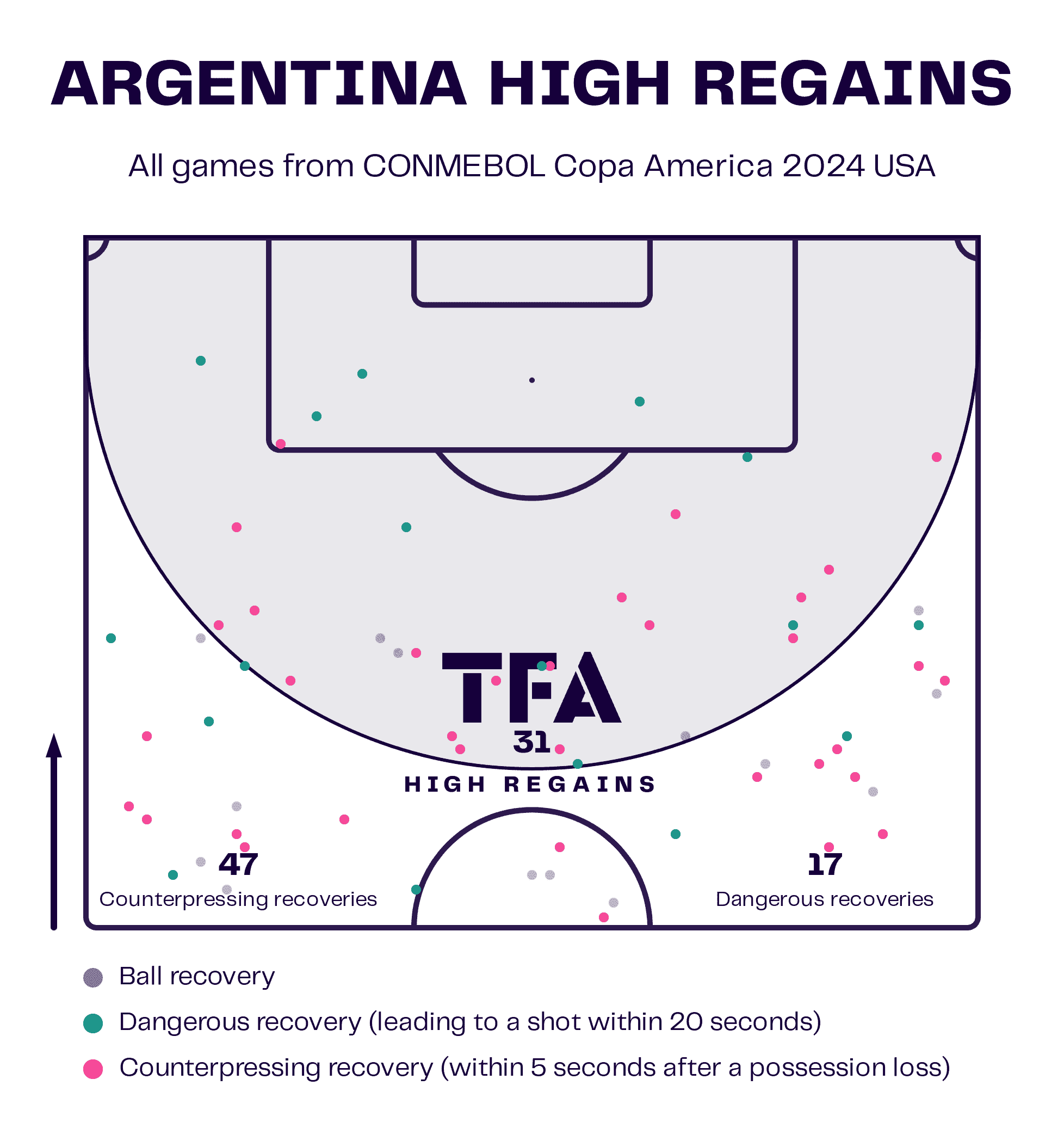
After playing three group stage games, Argentina’s PPDA sits at 6.89 — the second-lowest of any side in the competition, with most others having played just two games at the time of writing.
Within Scaloni’s counterpressing tactics, Argentina’s forwards have played a vital role in ensuring that the team effectively cuts the pitch in half, limiting the amount of space the opposition has to play out of pressure and get the ball moving forward.
We see one example of this principle in action in figure 2.
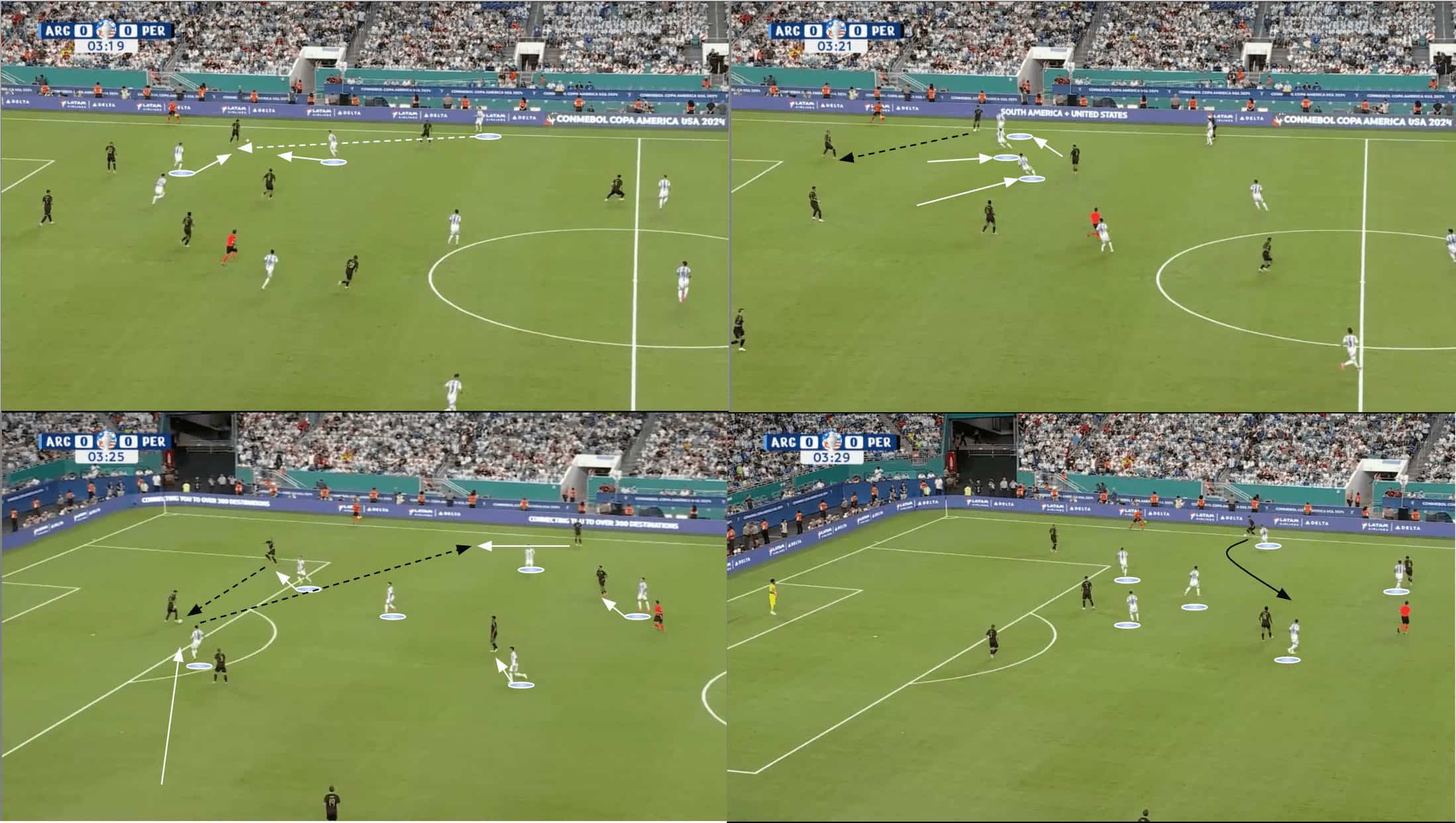
Firstly, after the opposition left-back makes the interception, we see Argentina’s ball-near central midfielder close that full-back down while the ball-near winger provides support and cover for that midfielder — as seen in the top two images of figure 2.
The opposition initially tries to play out of the pressure via the backline, with the left-back passing to the left centre-back, who relays possession to the right centre-back. However, now Argentina’s left-winger has arrived, pressing at an angle that forces the right-sided central defender to move the ball back over to the left side of the pitch.
Now, with their players’ intelligent defensive positioning and aggressive pressure mounting on the ball carrier, Argentina have successfully cut the pitch in half, denying the opponent access to the right, creating an advantageous situation for them to potentially force a high turnover.
In the bottom-right image above, we see very few options for the ball carrier, who actually does very well to dribble around the midfielder who’s pressing him aggressively, creating an opportunity for progression through the middle of the park. However, this took considerable skill and isn’t going to come off perfectly every time.
Argentina have used counterpressing tactics like this to turn high turnovers that could simply lead to a breakdown in possession and period of possession for the opposition to potentially build an attack into opportunities to force the opponent into uncomfortable positions that could give up goalscoring chances to La Albiceleste.
Meanwhile, on the defensive side of things, Argentina have been able to cut off opponents when building their attacks a fair bit through these counterpressing tactics, denying them comfortable ball progression and limiting their chances of progressing the ball into decent positions for chance creation further upfield.
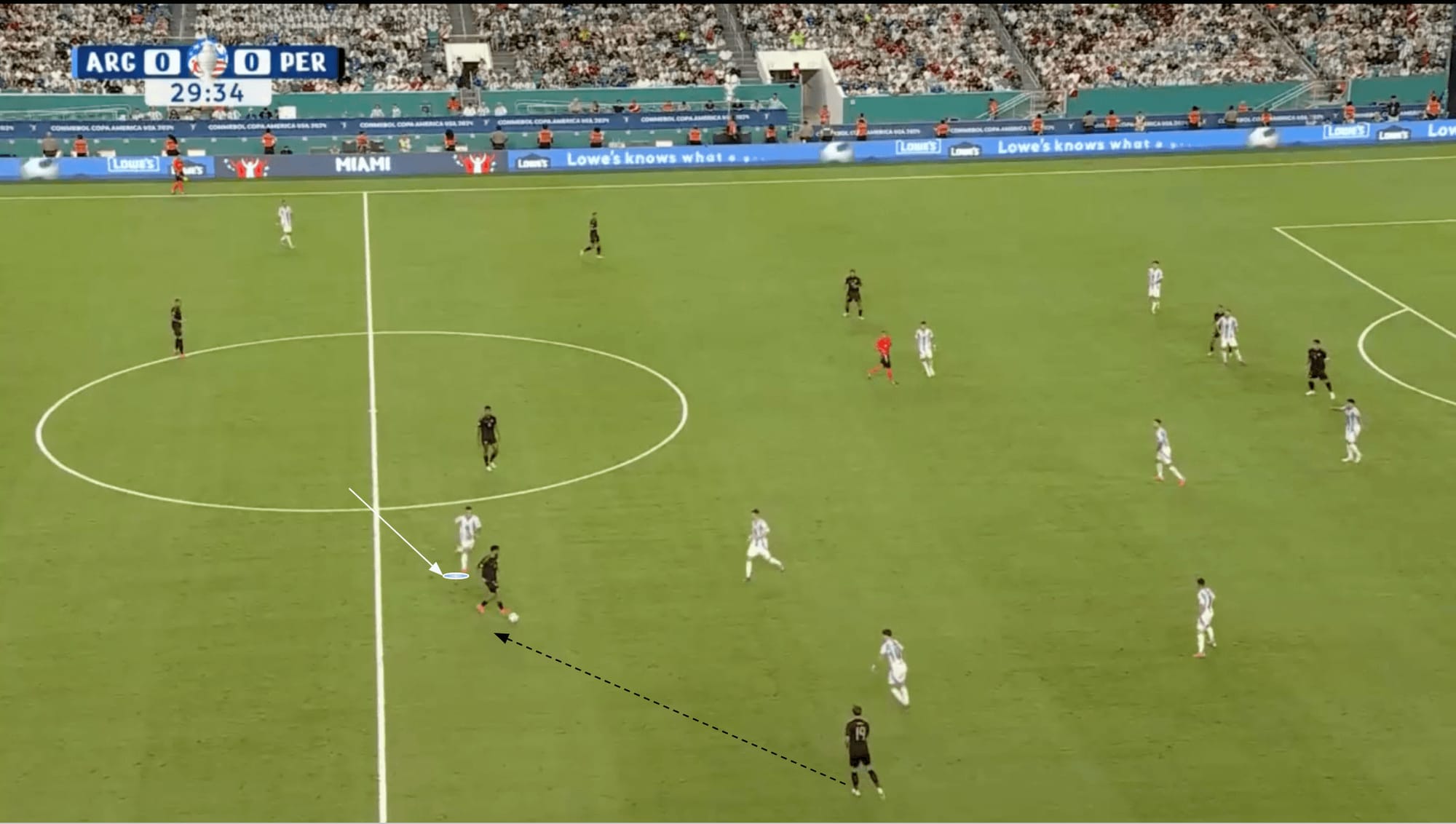
In addition to cutting the pitch in half, entering duels aggressively, especially when the opposition regain the ball and get a chance to build through the middle of the park, has been a key principle of Argentina’s counterpress, with Lautaro Martínez dropping from centre-forward to prevent the opponent receiving in midfield just after a turnover from being able to turn out and get his head up to pick out options ahead of him from a valuable position for ball progression.
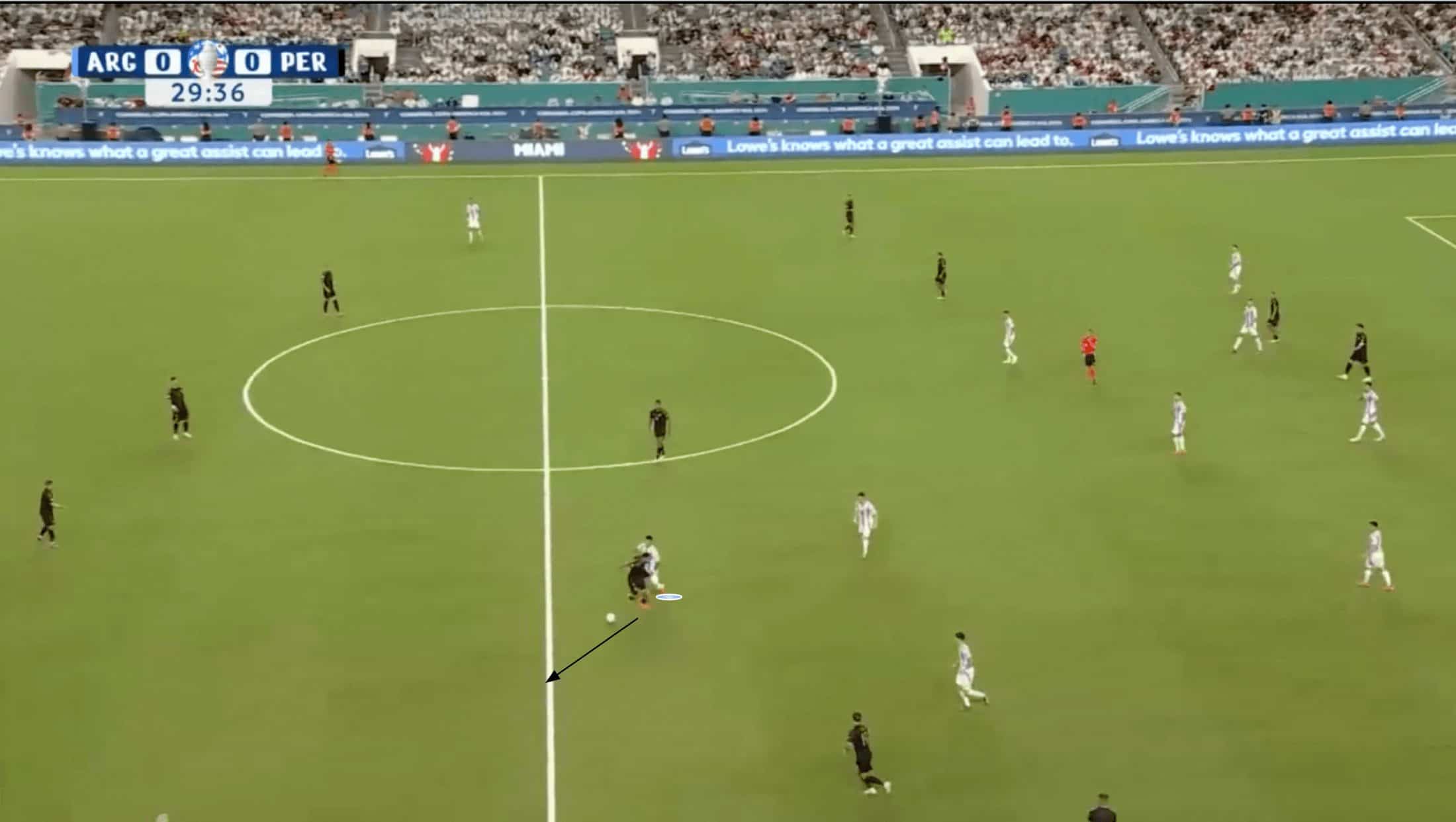
Martínez aggressively takes the attacker’s back and forces him away from midfield, ultimately committing a foul due to the aggressive and hasty nature of his approach here. However, Scaloni appears quite comfortable with his players committing a foul in this type of area if necessary when it prevents the opponent from taking advantage of their time and space in such a threatening central position from where they could put a teammate into a very favourable position if left alone.
Colombia
Moving on to Colombia, Néstor Lorenzo’s side have made 20 high regains, seven dangerous recoveries and 33 counterpressing recoveries in their first two Copa América 2024 games, with those numbers equalling 10.0 high regains, 3.5 dangerous recoveries and 16.5 counterpressing recoveries per match.
So, while they haven’t quite matched Argentina in their ability to quickly convert their recoveries into goalscoring opportunities, they’ve made a very similar number of high regains per 90 and even eclipse La Albiceleste in their quantity of counterpressing recoveries per 90.
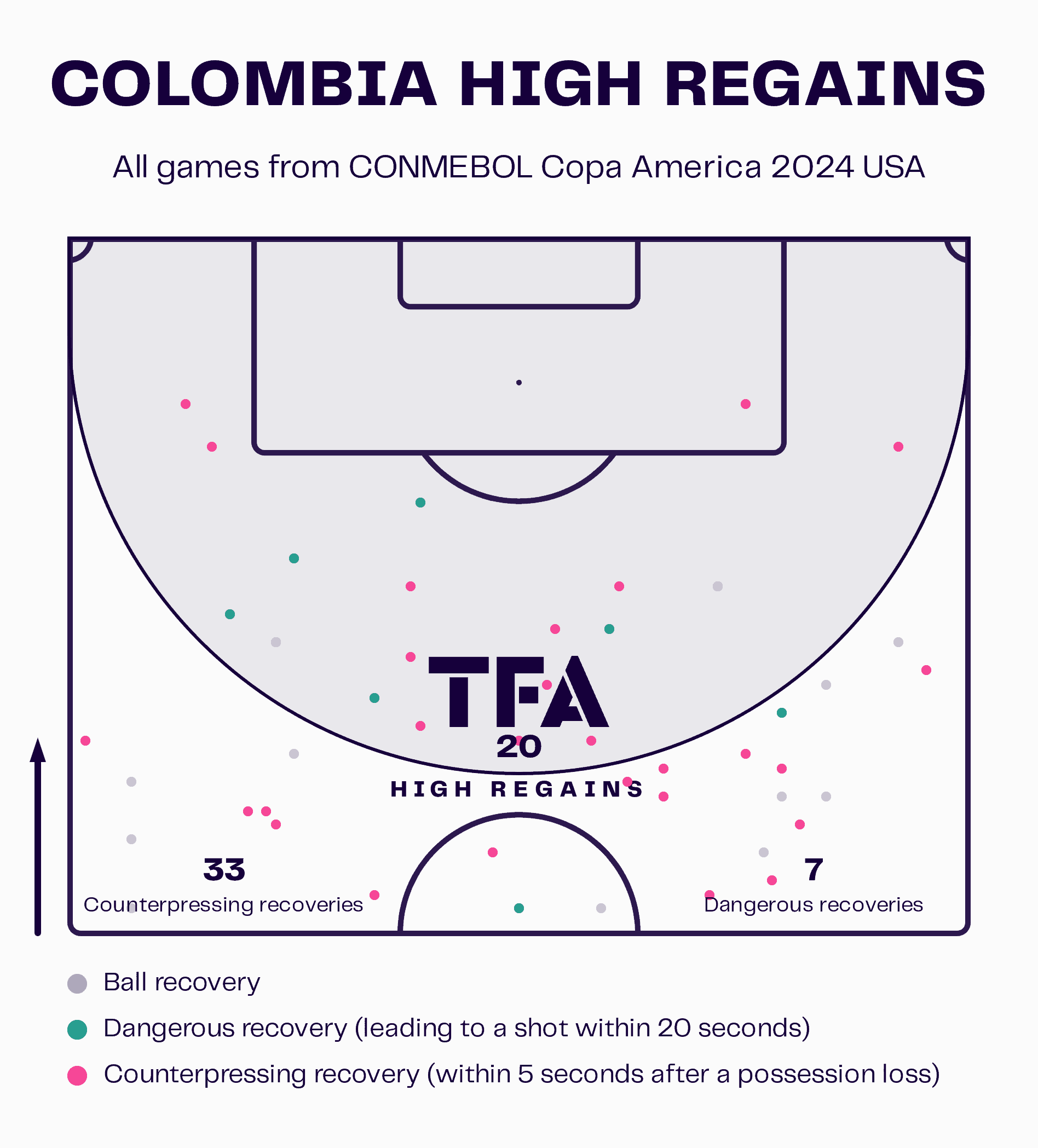
Colombia have been extremely aggressive in their pressing based on their opening two games of Copa América 2024, with Lorenzo’s side currently on the lowest PPDA (5.48) and highest challenge intensity (7.8) of any side in the tournament, based on their opening two group games.
Sprints from deep have been a critical component of Colombia’s counterpressing thus far in the tournament, with a player frequently advancing from deep to add numbers further upfield just after a turnover in order to overwhelm the opposition while ensuring Colombia’s general defensive structure remains solid, and most players don’t need to expend too much energy.
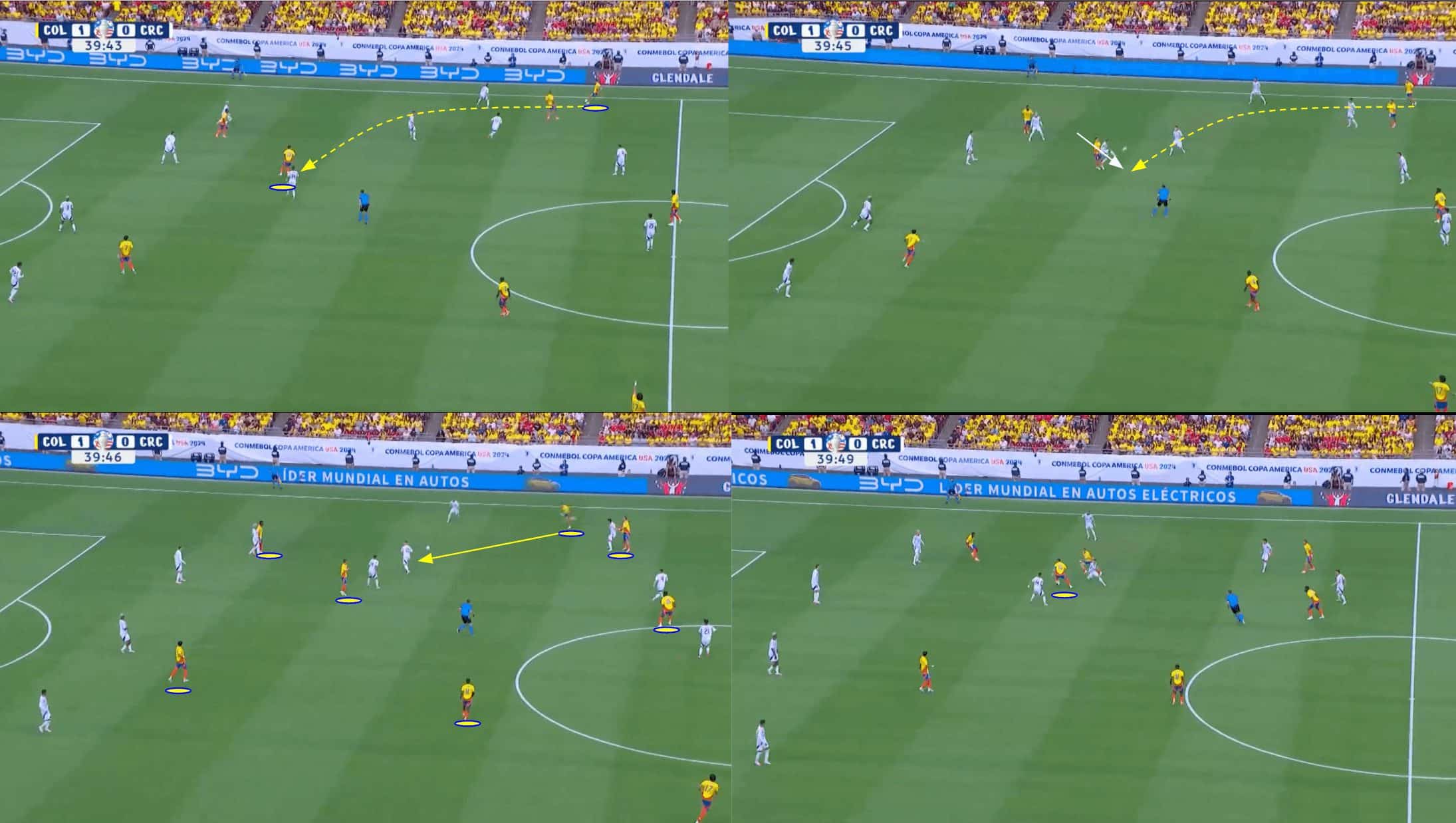
In this example shown in figure 6, we see Colombia’s right-back aiming for the ‘10’ with a progressive pass into the centre. However, the pass is intercepted as an opponent reads the Colombian players’ intentions well, thus returning possession to their side.
Immediately, as we progress into the bottom-left picture of figure 6, the right-back who’d played the initial ball forward is sprinting forward towards the new ball carrier, intending to put him under pressure. At the same time, Colombia’s forward line and midfield line can remain largely in the same positions they had been occupying, with Lorenzo’s 4-3-1-2 naturally offering good central coverage.
With the addition of the right-back into this area of the pitch chasing down the ball carrier aggressively and the rest of Colombia’s players all blocking off nearby passing options, Los Cafeteros force a turnover inside the opposition’s half just on the edge of the final third, highlighting the benefit of their counterpressing tactics.
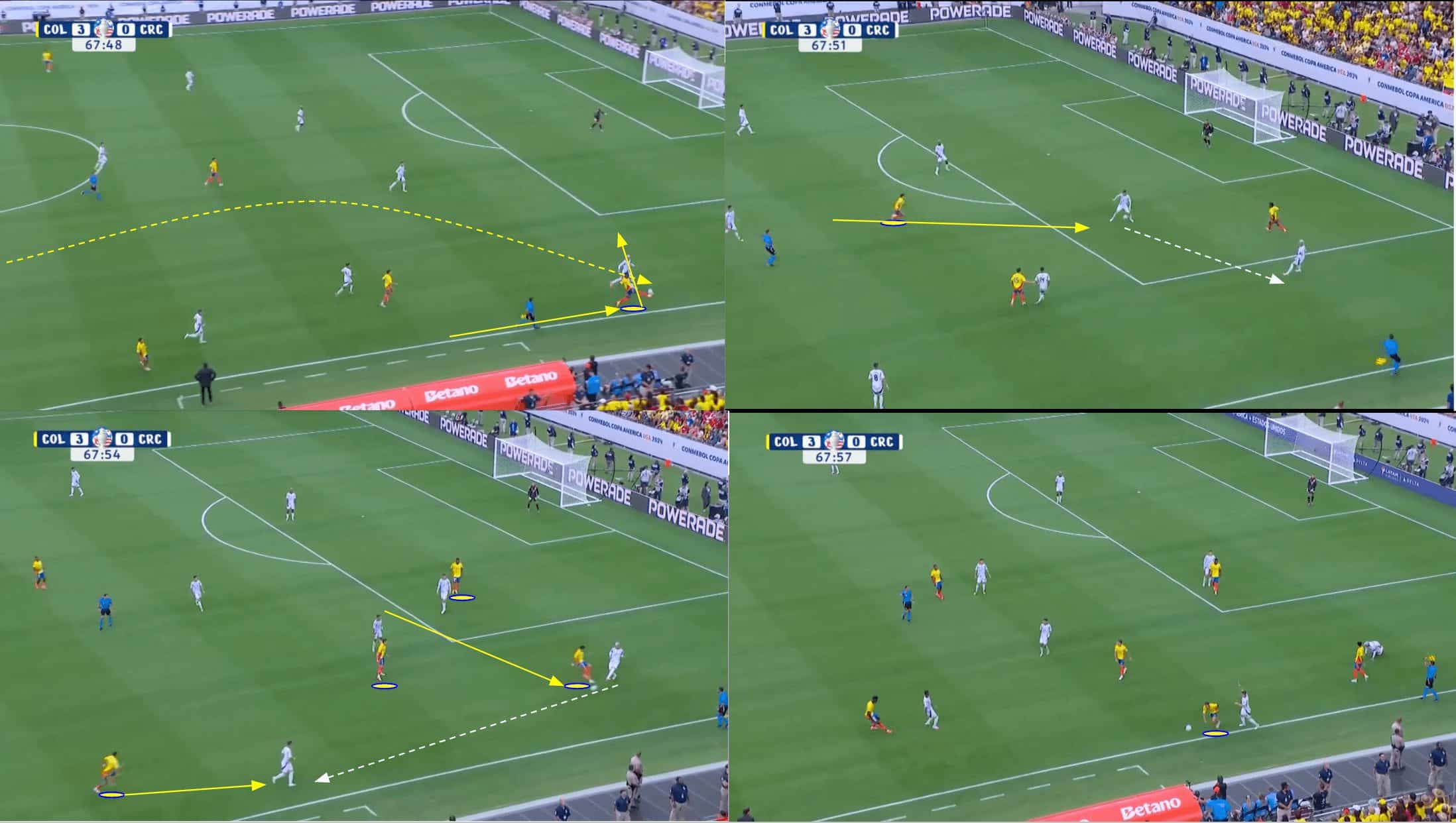
Our next image provides another example of how Colombia’s forward sprints have proven invaluable during the transition to defence in Copa América thus far.
In this case, we see Colombia losing the ball just on the edge of the box in the top two images, with their ‘10’ immediately beginning to sprint forward and chase down the ball carrier as the Costa Rican left centre-back plays the ball out to the left-back.
The ‘10’ continues his aggressive movement forward and rushes the left-back into a forward pass down the wing, which sets the next receiver up to be dispossessed by the right-back, who’s positioned just behind. However, on this occasion, Colombia’s aggressive pressure backfired, as they ended up giving away a foul, letting the opposition off.
Still, the potential benefits of their aggressive counterpress are clear from this play. One player’s aggressive sprinting from deep towards the ball carrier combines with the intelligent positioning of other players, which results from their natural positions within the 4-3-1-2 system, to congest the space around the ball carrier and deny them many good passing options, while Colombia aim to quickly win the ball back.
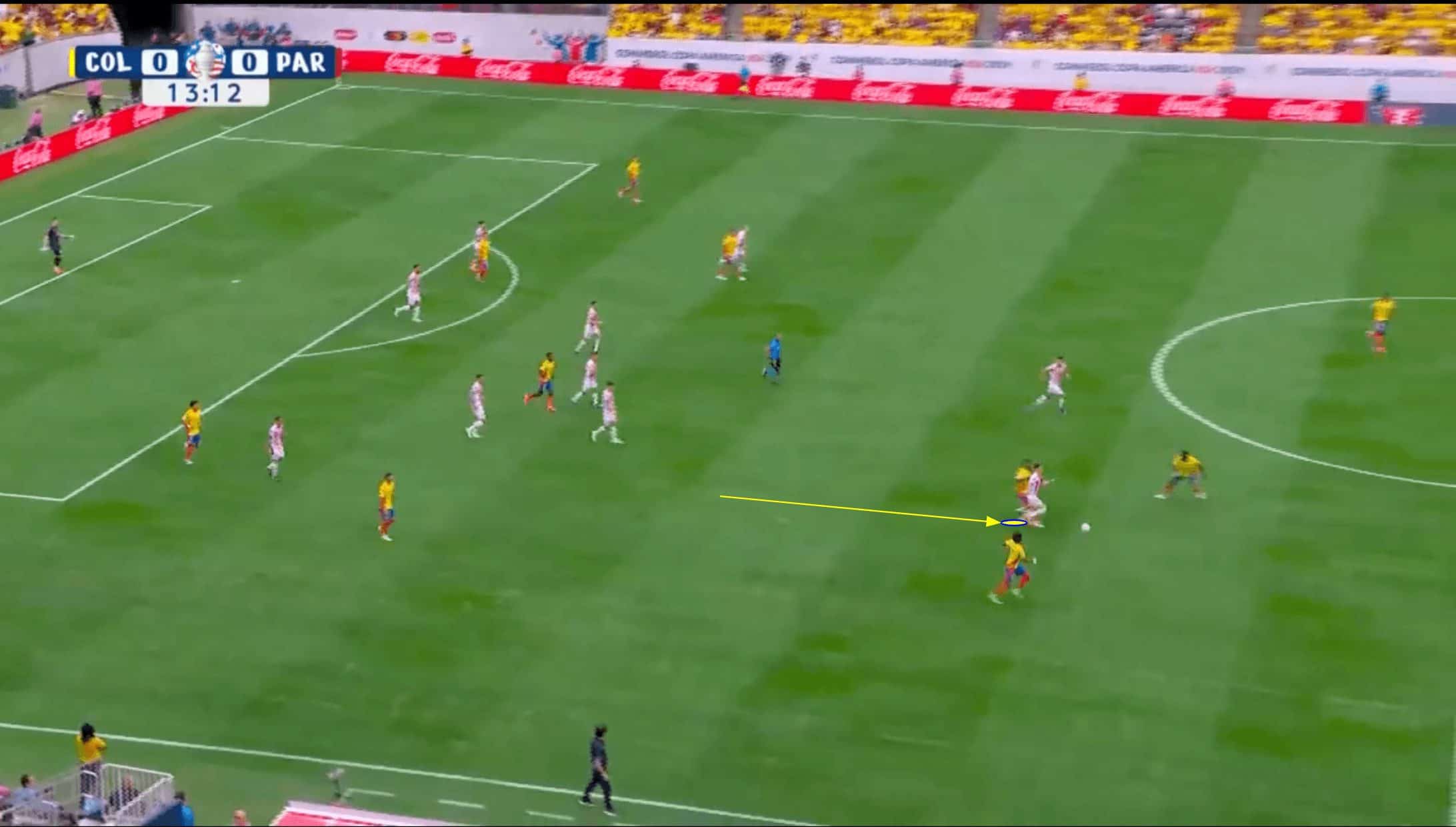
Like Argentina, Colombia are prone to committing what you may call ‘tactical fouls’ in defensive transitions, as we see in figure 8.
In fact, Colombia have committed the fourth-most fouls per 90 (13.45) of any side in Copa América thus far, with plenty of them coming during defensive transitions like the one above.
As with Argentina, Colombia are happy to commit fouls in this area when under threat on the counterattack rather than wait for the opponent to progress into a more threatening position further upfield, where the consequences of such a foul are unlikely to be grave. Though this is a foul, this type of foul is a common part of possession-based sides’ tactics in defensive transitions, and Colombia have shown more than any side how this can be beneficial during Copa América’s group stage.
Uruguay
Lastly, Uruguay are another side performing well in the Copa América group stage for whom counterpressing has played a key tactical role. As figure 9 displays, they’ve made 26 high regains, 36 counterpressing recoveries and 14 dangerous recoveries in their opening two group stage games, with those numbers totalling 13.0 high regains, 18.0 counterpressing recoveries and 7.0 dangerous recoveries per match — more than Colombia and Argentina, respectively, in each statistic.
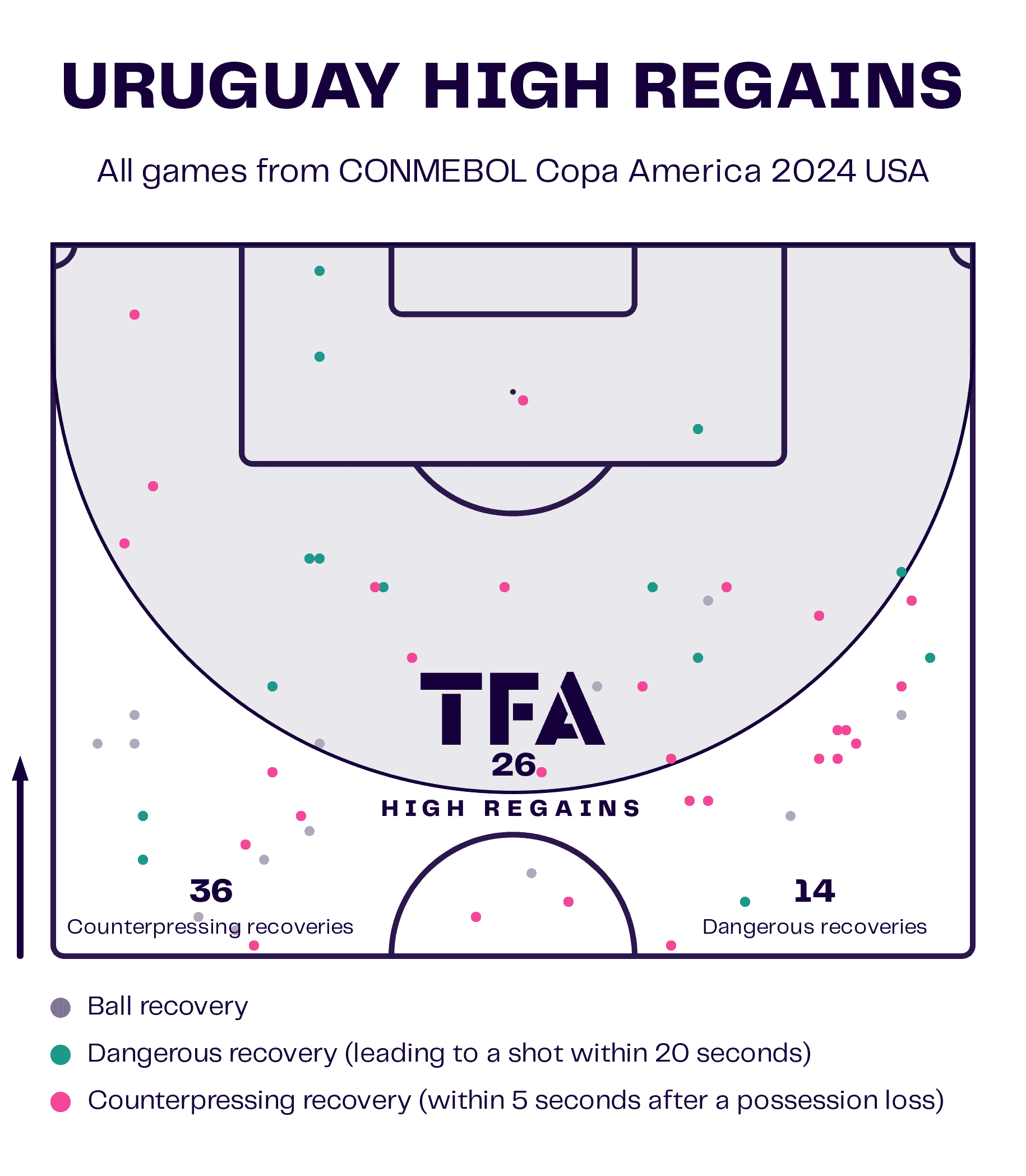
From their opening two group stage games, Marcelo Bielsa’s side have tallied up a PPDA of 8.13 — the third-lowest in the competition at the time of writing — and a challenge intensity of 6.4 — the third-highest of any side in Copa América 2024 at the time of writing, indicating the relative high intensity of their off-the-ball approach.
When it comes to counterpressing, Uruguay’s organised possession approach has played an important role, with players’ close proximity in the rest defence as La Celeste attempt to break down the opponent and build a goalscoring opportunity with the ball both serving to create passing opportunities as well as have players prepared to react quickly and counterpress should they turn the ball over.
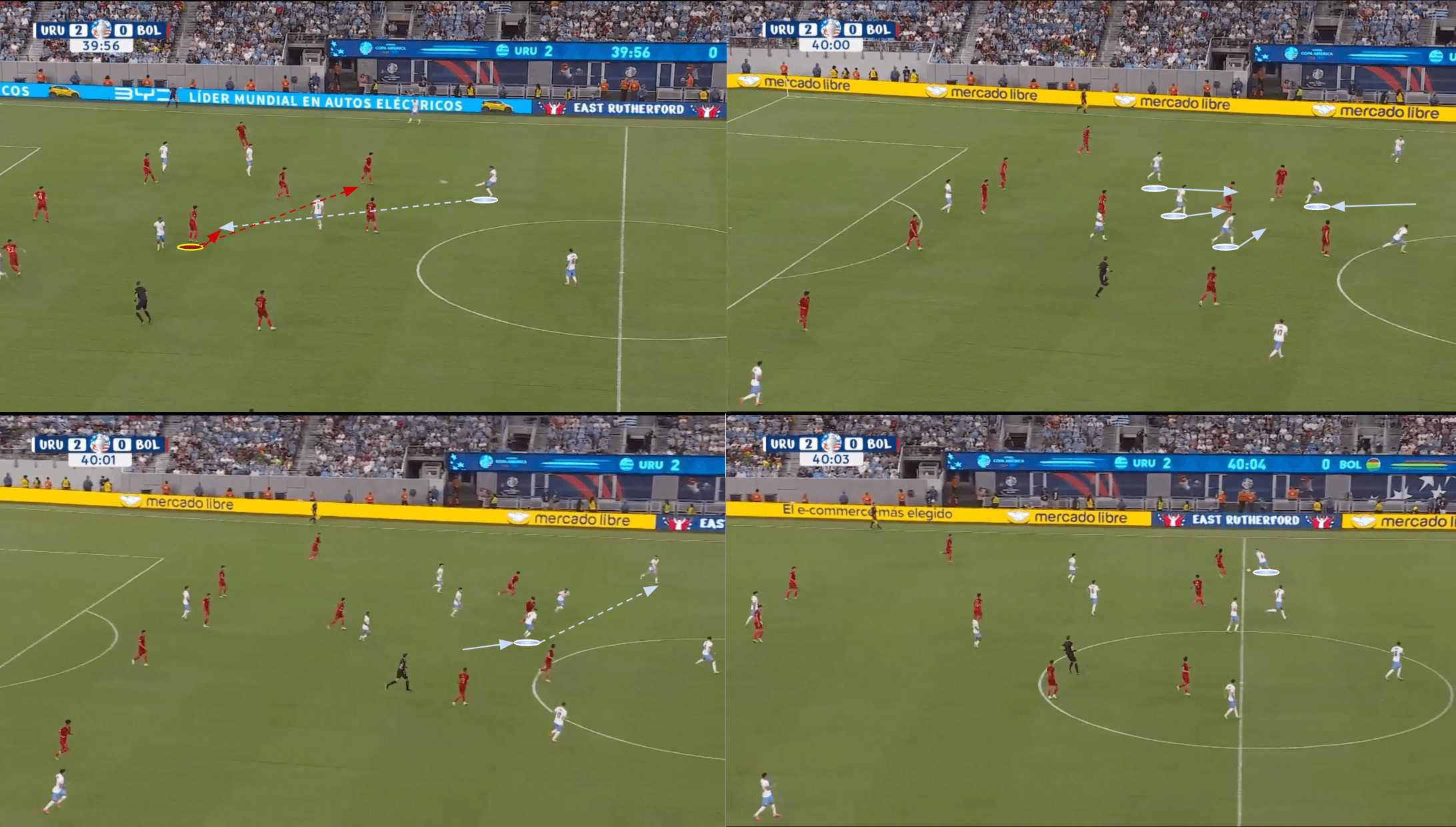
Here, we can see Ronald Araújo attempting a line-breaking progressive pass into the final third from the right centre-back position. However, the opposition read the play well, with one opponent pulling off a solid interception before knocking the ball forward to a teammate.
As the teammate receives, Araújo himself immediately pushes up to deny that opponent the opportunity to fully turn and face Uruguay’s defence while also limiting his space on that side. At the same time, three nearby Uruguayans begin dropping back in support of the centre-back, who’s jumped out of the backline to press.
All of this quickly creates a significant amount of pressure on the ball carrier, who’s then forced into a mistake and ultimately gives possession back to Uruguay inside the Bolivian half, allowing Marcelo Bielsa’s side to have another go at breaking them down.
This is a perfect passage of play to highlight the benefit of having players relatively close together in possession in the middle of the park for when a turnover occurs — it enables the team who’s just lost the ball to quickly swarm around the opposition ball carrier and puts them in a good position to win the ball back, as was the case here.
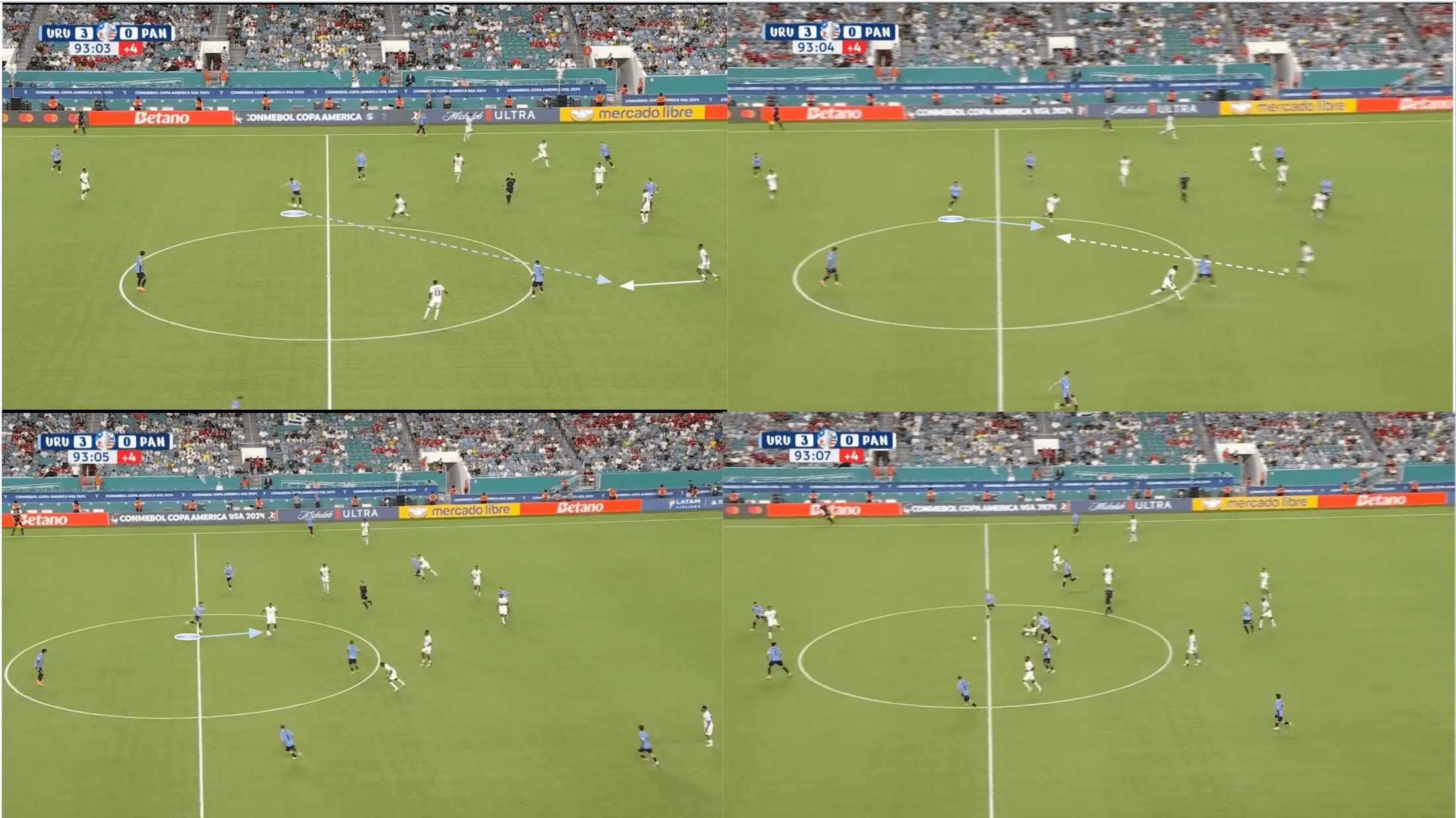
Uruguay have also commit fouls, at times, during their defensive transitions in safe areas to shut down opposition counterattacks before they progress to a really dangerous area — we see an example of this in figure 11 when the midfielder who’d just given the ball away in midfield takes down an opponent who receives before attempting to turn and carry towards the Uruguayan backline.
As was the case with Argentina and Colombia, this isn’t a particularly dangerous foul, nor is it in a threatening area—it’s a minor foul. However, in the grand scheme of Uruguay’s transitional defence, it’s important as a precautionary measure against the opposition counter.
Conclusion
In conclusion, aggressive counterpressure has been a vital element of Argentina, Colombia and Uruguay’s respective success in Copa América thus far, with each side demonstrating great examples of popular counterpressing principles during the tournament.
With all three of these sides representing group stage standouts, it’s clear that good counterpressing has been one of the most important tactical weapons in Copa América this year, with our chosen examples providing evidence of why.

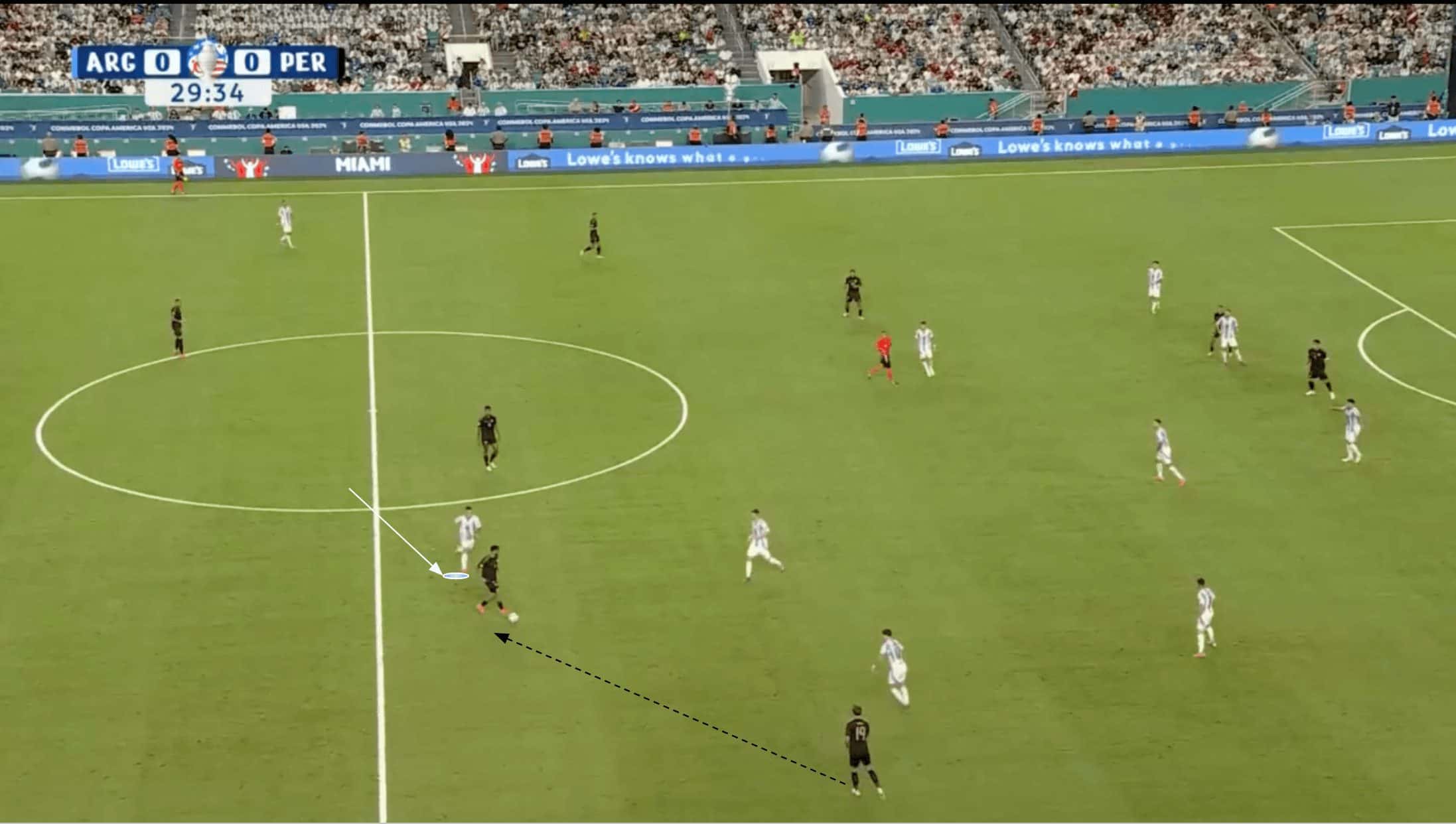



Comments